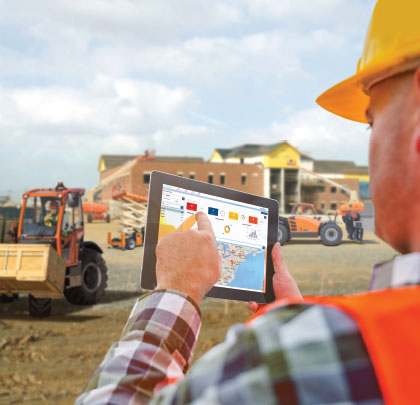As fleet owners search for ways to better monitor and manage their equipment, telematics is gaining traction in the construction industry and playing an increasingly more important role on jobsites. Telematics is the use of wireless technology to gather and transmit data—data regarding equipment performance, health, location, and run hours—to improve equipment efficiency, reduce costs, and ultimately increase profits.
Responding to the increased use of telematics on jobsites, the International Organization for Standardization recently published the Association of Equipment Management Professionals (AEMP) Telematics Standard, ISO 15143-3. The standard was submitted to provide manufacturers, equipment users, fleet managers, and all industry stakeholders with a data standard for specific data points that adhere to a specific format. It allows fleet managers and contractors to aggregate data into one display for easy analysis, increasing jobsite productivity and cost effectiveness in the process.
OEMS AND TELEMATICS PROVIDERS
Until recently, the technology that makes telematics possible was only available from third-party providers. Today, with increasing frequency, original equipment manufacturers (OEMs) partner with telematics providers and produce equipment with integrated telematics. Doing so ensures OEMs receive the most up-to-date technologies without investing the time and money required to build a telematics platform. That’s because telematics providers bring a wealth of experience and knowledge about telematics and wireless technology to a solution, exceeding the abilities of the OEM in most cases. Additionally, when partnering with a telematics provider, OEMs respond more quickly to industry changes and trends and help create telematics designed to their specific requirements and the demands of customers.
For fleet owners and managers, the benefits telematics offer begins with fleet management—knowing when, where, and how equipment is used and how it is performing on the jobsite based on the abundance of data technology that is available to owners. In fact, data is at the heart of any successful telematics solution. Big data is a repository for information that reports on everything a machine is doing at any given time. Without the expertise a telematics provider offers, this data is overwhelming to the fleet owner or machine operator. A telematics solution gathers the information that is most meaningful to owners and operators and displays it in a way that is understandable and actionable.
IMPROVED PERFORMANCE, PRODUCTIVITY
Having information available enables owners and operators to make informed decisions regarding machine performance and productivity. It also allows them to stay up-to-date on routine maintenance and limit time lost due to low batteries and unexpected failures. Additionally, owners and customers who use a telematics solution are better equipped to identify shortcomings with the equipment, evaluate their impact, and recommend design improvements to the OEM that address these shortcomings. And, when a fleet consists of multiple machines manufactured by the same OEM, fleet managers feel more confident knowing that similar information is available across multiple machines.
JLG TELEMATICS SOLUTION
An example of a successful telematics system includes JLG® ClearSky™, a fleet management telematics solution that provides more focused, meaningful data delivered in a cost-effective tool. ClearSky combines multi-year service plans and several hardware options that provide equipment owners and operators with flexible options to access critical engine and equipment operational data. Data points, including location, engine hours, usage, fuel and battery levels, and maintenance schedules, are conveniently available in real time and accessible from desktop or mobile devices. Owners can even set up geofences and time fences to protect their fleet. The dashboard, settings, and a library of widgets edit and prioritize according to customer preferences.
The system also monitors fault codes and other critical alerts which send via text and email. Additionally, ClearSky data integrates with customers’ enterprise resource planning (ERP) software for seamless fleet management. Data is transmitted securely from anywhere in the world using cellular technology or satellite communications, depending upon the device installed to suit the geographic location of the asset. All transmissions route through a secure data center to a customer’s business system or through a user-friendly web interface available on desktops and mobile devices.
Telematics solutions like ClearSky are offered as a factory-installed option for new machines or as an aftermarket installation kit to retrofit equipment in the field. They provide an affordable, easy-to-use method of managing and maintaining a fleet by giving fleet owners the actionable data they need and the reports that will help them make informed decisions about their equipment. These reports can be fashioned in such a way as to provide only the information they need, freeing them from devoting time and energy looking at information they do not consider critical to their operation.

JLG® 800AJ Articulating Boom Lift equipped with ClearSky™
CONNECTED JOBSITES
As fast as technology changes, so do the offerings of telematics solutions. Looking ahead, equipment owners can anticipate solutions that incorporate predictive maintenance, access control systems, fleet analytics, preemptive parts replacement and service, and equipment monitoring within a related portfolio of services. Eventually, technology will use the Internet of things to create an interconnected network that ties together equipment, devices, people, worksites, and buildings. Sensors on everything from machine components to material on pallets and jobsite wearables, including vests, gloves, and boots, provide real-time data to project managers, foremen, site supervisors, and safety directors regarding site operations through a simple dashboard. The system allows for simultaneous viewing and quick decision-making regarding equipment performance, as well as worker fatigue, overheating, productivity, and safe operating practices. The system will also alert and dispatch service vehicles when a machine requires preventive maintenance or repair work.
Telematic solutions on the jobsite are making their mark in positive ways, evolving as technology evolves and end-user requirements change. Those who recognize the value they deliver day-by-day, minute-by-minute are better positioned to take full advantage of the jobsite of the future.
About the Author:
Jon Shapiro is the global telematics manager of JLG Industries, Inc. For more information, visit www.jlg.com.
_________________________________________________________________________
Modern Contractor Solutions, June 2018
Did you enjoy this article?
Subscribe to the FREE Digital Edition of Modern Contractor Solutions magazine.



